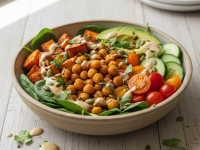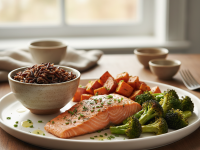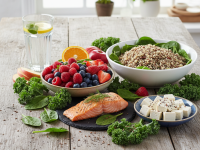Hey there, fellow food adventurers and wellness warriors! Let’s be real for a moment. In our fast-paced lives, it often feels like there’s a constant tug-of-war between eating healthy, supporting our gut, and simply finding the time to cook something delicious. Am I right? We’re all striving for that elusive balance, but sometimes, convenience wins, and our gut health takes a back seat.
That’s exactly where I was a few years ago. Juggling work, family, and a million other things, I found myself relying on quick fixes that left my digestion feeling… well, not so great. I knew I needed more probiotics in my diet, but store-bought fermented foods can be pricey, and making elaborate homemade ferments felt like another chore I just couldn’t add to my plate. Then, a friend introduced me to the magic of simple vegetable ferments, and my world (and my gut!) changed for the better. And today, I’m so excited to share my absolute favorite, go-to recipe: a vibrant, tangy, and incredibly gut-friendly Fermented Carrot & Ginger Slaw.
This isn’t just another recipe; it’s a testament to how easy and delicious gut wellness can be, even on your busiest weeknights. Trust me, if I can fit this into my chaotic schedule, you absolutely can too. It requires minimal effort, just a few ingredients, and a little patience (mostly while it happily ferments away on your counter!). Let’s dive in and get your gut feeling good!
Why Fermentation is Your Gut’s Best Friend (and Mine Too!)
Before we get to the fun part of shredding and mixing, let’s chat for a minute about why fermentation is such a superstar for our health. You’ve probably heard the buzz about probiotics, but what exactly does “fermented” mean in plain English?
Simply put, fermentation is a natural process where beneficial microorganisms (bacteria, yeasts) break down carbohydrates into acids, gases, or alcohol. For us, this means transforming simple vegetables into powerhouse foods packed with probiotics – those friendly bacteria that populate our gut. Think sauerkraut, kimchi, yogurt, kombucha… and our amazing slaw!
For me, embracing fermented foods was a game-changer. I used to struggle with bloating and inconsistent digestion, which, let’s just say, wasn’t exactly making me feel my most vibrant. Once I started regularly incorporating ferments like this carrot slaw, I noticed a significant improvement in my digestion, a boost in my energy levels, and even a clearer mind. It’s like my gut biome finally said, “Ah, thank you! We’ve been waiting for this party!”
Beyond the probiotics, fermentation also makes the nutrients in food more bioavailable, meaning your body can absorb and utilize them more easily. It also preserves food naturally and, perhaps most delightfully, creates incredible, complex flavors that you just can’t get any other way. That tangy, slightly effervescent crunch of this slaw? Pure fermented magic!
Beyond the Brine: What Makes This Slaw So Special?
Now, let’s talk about the star ingredients: carrots and ginger. While fermentation itself is powerful, the combination of these two humble ingredients elevates this slaw into a nutritional and flavor powerhouse.
-
Carrots: These vibrant root vegetables are much more than just a pretty color. They’re loaded with beta-carotene (which your body converts to Vitamin A, essential for vision and immune function), fiber (hello, healthy digestion!), and a good dose of antioxidants. The fiber in carrots acts as a prebiotic, feeding those good bacteria we just talked about. Plus, once fermented, carrots develop an incredible depth of flavor and a lovely, tender-crisp texture.
-
Ginger: Oh, ginger, how I love thee! This pungent root is a true digestive superhero. It’s renowned for its anti-inflammatory properties and its ability to soothe an upset stomach, alleviate nausea, and aid in digestion. The warming, spicy kick of fresh ginger also perfectly balances the sweetness of the carrots and the tang of the fermentation. I’ve personally found that adding ginger to my meals helps keep my digestion smooth and comfortable, especially after a larger meal.
Together, carrots and ginger create a synergy that is not only delicious but also incredibly beneficial for your gut and overall well-being. It’s a flavor profile that’s both familiar and exciting, making it super easy to incorporate into almost any meal.
My Foolproof Recipe: Fermented Carrot & Ginger Slaw (No Fancy Equipment Needed!)
Ready to get your hands a little messy (in the best way possible)? Here’s my go-to recipe. What I love most about this is its simplicity. You don’t need expensive fermentation crocks or airlocks to get started. A clean glass jar and a little weight are all you really need!
The Magic Ingredients You’ll Need:
- Approximately 1 kg (about 2.2 lbs) organic carrots, scrubbed clean (no need to peel if organic!)
- 2-3 inches fresh ginger, peeled
- 1-2 tablespoons sea salt (non-iodized, please! Iodine can interfere with fermentation)
- Filtered water (chlorine can inhibit fermentation)
A note on salt: The amount of salt can vary slightly depending on your preference and the specific salt you use. A good general rule is 2% of the vegetable weight. For 1kg of carrots, that’s 20g of salt, which is roughly 1-2 tablespoons. I usually start with 1 tablespoon and add more if needed. You want it to taste salty, but not overpoweringly so – remember, the fermentation process will mellow it out a bit.
Step-by-Step Fermentation Fun:
-
Prepare Your Carrots: Using a mandoline, food processor with a shredding disc, or a good old-fashioned box grater, shred your carrots. I personally love the texture from a mandoline’s juliee setting or a coarser shred from a food processor. It makes for a beautiful, uniform slaw.
-
Grate the Ginger: Using a microplane or the fine side of your grater, grate the fresh ginger directly over the shredded carrots. You want those fiery little bits distributed evenly.
-
Salt and Massage: Place the shredded carrots and ginger in a large, clean mixing bowl. Sprinkle with 1 tablespoon of sea salt. Now, here’s the fun (and crucial) part: with clean hands, vigorously massage the carrots and ginger. Squeeze, squish, and mash them for about 5-10 minutes. You’ll notice the carrots starting to soften and release their own liquid. This liquid, combined with the salt, will create the brine for fermentation. This step is vital for drawing out enough liquid to submerge the vegetables, which is key to preventing mold.
-
Pack the Jar: Tightly pack the carrot and ginger mixture into a clean, wide-mouth glass jar (a quart-sized Mason jar works perfectly). Press down firmly to remove any air pockets. As you press, more liquid should rise to the surface. You want the vegetables to be completely submerged under their own briny liquid. This creates an anaerobic (oxygen-free) environment, which is ideal for the good bacteria to thrive and prevents undesirable mold from growing.
-
Submerge (If Needed): If your carrots haven’t released enough liquid to completely cover themselves, don’t fret! Mix a solution of 1 teaspoon sea salt per 1 cup of filtered water. Add just enough of this brine to ensure all the carrots are fully submerged. This is a common occurrence, especially if your carrots aren’t super juicy.
-
Weigh it Down: Place a small fermentation weight (or a clean, smaller jar/rock that fits inside your main jar) directly on top of the carrots to keep them submerged under the brine. This is so important! Any bits of vegetable exposed to air can mold.
-
Seal and Wait: Lightly cover the jar with a lid (don’t seal it tightly, as gases need to escape) or use an airlock if you have one. Place the jar on a plate or in a bowl (just in case some brine overflows during active fermentation) in a cool, dark spot in your kitchen, away from direct sunlight. Ideal fermentation temperature is typically between 18-24°C (65-75°F).
-
The Waiting Game (and Burping): Let it ferment for 3-7 days. The exact time depends on the temperature of your kitchen and your desired level of tanginess. During this time, you might see small bubbles forming – that’s a good sign! It means the bacteria are busy at work. “Burp” your jar daily by briefly opening the lid to release any built-up gases. After a few days, give it a taste test. Once it reaches your preferred level of tanginess, remove the weight, seal the jar tightly, and transfer it to the refrigerator. This will slow down the fermentation process significantly.
Troubleshooting & Tips for Fermentatioewbies (Trust Me, I’ve Been There!)
If you’re new to fermenting, you might have a few questions or concerns. Don’t worry, I’ve made my fair share of “fermentation experiments” that didn’t quite go as plaed. Here are some common things to watch out for:
-
Is that mold? Or Kahm Yeast? Sometimes a white film can form on the surface. If it’s fuzzy, colorful (green, black, pink), or smells terrible, it’s mold – discard the batch. However, if it’s a thin, white, wrinkly film that smells yeasty or benign, it’s likely Kahm yeast, which is harmless. You can skim it off, and the ferment underneath should be fine. To prevent it, ensure your veggies are always submerged and your tools are clean.
-
Too Salty/Not Salty Enough: This comes with practice. If it’s too salty, you can rinse it lightly before eating or mix it with fresh, unfermented veggies. If not salty enough, it might not ferment properly or could develop off-flavors. Aim for that 2% salt ratio for safety and flavor.
-
How Long Does it Last? Once refrigerated, your fermented carrot and ginger slaw can last for several weeks, even months! The flavors will continue to develop, becoming more complex over time. Just ensure it always smells fresh and appetizing.
-
Temperature Matters: Cooler temperatures slow down fermentation, while warmer temperatures speed it up. If your kitchen is very warm, keep an eye on it, as it might be ready sooner than expected. If it’s too cool, it might take longer to get going.
My biggest piece of advice? Don’t be afraid to experiment! Fermentation is an ancient art, and every batch is a little unique. You’ll learn what works best in your kitchen environment over time.
Beyond the Bowl: Creative Ways to Enjoy Your Slaw
Now that you’ve mastered the art of making this incredible slaw, how do you enjoy it? The possibilities are endless!
-
Classic Side Dish: It’s perfect alongside almost any main course – grilled chicken, roasted fish, a hearty lentil soup, or even a simple omelet. The tanginess cuts through richness beautifully.
-
Taco & Bowl Topping: Add a generous spoonful to your tacos, burritos, grain bowls, or Buddha bowls for a burst of flavor and probiotics.
-
Sandwich & Wrap Filler: Elevate your lunch! This slaw adds an amazing crunch and zing to sandwiches and wraps. It’s a fantastic alternative to pickles or traditional coleslaw.
-
Salad Booster: Mix it into your green salads for an extra layer of texture and a probiotic punch.
-
Straight from the Jar: Confession time – sometimes I just grab a fork and eat it straight from the jar as a quick, healthy snack. It’s that good!
It’s incredibly versatile, and its bright, tangy flavor makes it a fantastic addition to so many meals. I find it adds a fresh, zesty note that makes even simple weeknight diers feel a little more gourmet.
Conclusion
So there you have it – my secret to a happy gut, even when life gets hectic. This Fermented Carrot & Ginger Slaw is more than just a recipe; it’s an invitation to take a simple, delicious step towards better health. It’s a testament to the fact that nourishing your body and boosting your gut doesn’t have to be complicated, time-consuming, or expensive.
By investing just a little bit of time upfront, you’ll have a jar full of probiotic goodness ready to enhance your meals for weeks to come. You’ll feel the difference in your digestion, enjoy the vibrant flavors, and gain the satisfaction of making something truly wholesome with your own hands. So, go ahead, give this recipe a try. Your gut (and your taste buds!) will thank you. Happy fermenting!
1. A close-up, top-down shot of a beautifully vibrant, freshly prepared fermented carrot and ginger slaw in a rustic ceramic bowl, garnished with a few sprigs of fresh dill or cilantro. In the soft-focus background, a sealed glass fermentation jar with similar slaw peeking through. Natural light.
2. A four-panel composite image showing the process: Panel 1: Hands holding a mandoline shredding fresh carrots into a bowl. Panel 2: Fresh ginger being grated over the shredded carrots. Panel 3: Hands vigorously massaging the shredded carrots and ginger in a bowl, with some liquid forming at the bottom. Panel 4: The prepared slaw tightly packed into a glass Mason jar with a small glass weight keeping it submerged under liquid, ready for fermentation.
3. A delicious, healthy weeknight meal featuring the fermented carrot and ginger slaw prominently as a colorful side dish. The meal could be grilled salmon or chicken with quinoa and some greens, or a vibrant plant-based power bowl. The slaw adds a pop of color and freshness, making the whole meal look appealing and balanced.



